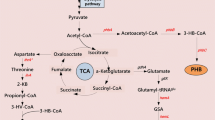Abstract
A new poly(3-hydroxypropionate) (P3HP) biosynthetic pathway employing β-alanine as an intermediate from an inexpensive carbon source was developed in recombinant Escherichia coli. After a series of systematic optimization, the genes for L-aspartate decarboxylase and its maturation factor (panD and panM, from E. coli), β-alanine-pyruvate transaminase (pp0596, from Pseudomonas putida), 3-hydroxy acid dehydrogenase and 3-hydroxypropionyl-CoA synthase (ydfG and prpE respectively, from E. coli), and polyhydroxyalkanoate synthase (phaC1, from Cupriavidus necator) were cloned and expressed in E. coli. Under shake-flask conditions, the recombinant strain produced 0.5 g P3HP l−1 from glycerol and glucose, up to 10.2 % of CDW. Though the content of P3HP was low, this pathway has some advantages over other reported pathways, such as being redox neutral, does not require any coenzyme, and can use a wide range of carbon sources.


Similar content being viewed by others
References
Anderson AJ, Dawes EA (1990) Occurrence, metabolism, metabolic role, and industrial uses of bacterial polyhydroxyalkanoates. Microbiol Rev 54:450–472
Andreessen B, Steinbuchel A (2010) Biosynthesis and biodegradation of 3-hydroxypropionate-containing polyesters. Appl Environ Microbiol 76:4919–4925
Andreessen B, Lange AB, Robenek H, Steinbuchel A (2010) Conversion of glycerol to poly(3-hydroxypropionate) in recombinant Escherichia coli. Appl Environ Microbiol 76:622–626
Cao A, Kasuya K, Abe H, Doi Y, Inoue Y (1998) Studies on comonomer compositional distribution of the bacterial poly (3-hydroxybutyric acid-co-3-hydroxypropionic acid)s and crystal and thermal characteristics of their fractionated component copolyesters. Polymer 39(20):4801–4816
Chen GQ (2009) A microbial polyhydroxyalkanoates (PHA) based bio- and materials industry. Chem Soc Rev 38:2434–2446
Chowdhury EK, Akaishi Y, Nagata S, Misono H (2003) Cloning and overexpression of the 3-hydroxyisobutyrate dehydrogenase gene from pseudomonas putida E23. Biosci Biotechnol Biochem 67:438–441
Fujisawa H, Nagata S, Misono H (2003) Characterization of short-chain dehydrogenase/reductase homologues of Escherichia coli (YdfG) and Saccharomyces cerevisiae (YMR226C). BBA-Proteins Proteom 1645:89–94
Fukui T, Suzuki M, Tsuge T, Nakamura S (2009) Microbial synthesis of poly ((R)-3-hydroxybutyrate-co-3-hydroxypropionate) from unrelated carbon sources by engineered Cupriavidus necator. Biomacromolecules 10:700–706
Green PR, Kemper J, Schechtman L, Guo L, Satkowski M, Fiedler S, Steinbuchel A, Rehm BHA (2002) Formation of short chain length/medium chain length polyhydroxyalkanoate copolymers by fatty acid β-oxidationinhibited Ralstonia eutropha. Biomacromolecules 3:208–213
Hayaishi O, Nishizuka Y, Tatibana M, Takeshita M, Kuno S (1961) Enzymatic studies on the metabolism of β-Alanine. J Biol Chem 236:781–790
Herter S, Fuchs G, Bacher A, Eisenreich W (2002) A bicyclic autotrophic CO2 fixation pathway in Chloroflexus aurantiacus. J Biol Chem 277:20277–20283
Liu Q, Luo G, Zhou XR, Chen GQ (2011) Biosynthesis of poly (3-hydroxydecanoate) and 3-hydroxydodecanoate dominating polyhydroxyalkanoates by β-oxidation pathway inhibited Pseudomonas putida. Metab Eng 13:11–17
Liu CS, Wang Q, Xian M, Ding YM, Zhao G (2013) Dissection of malonyl-coenzyme A reductase of Chloroflexus aurantiacus results in enzyme activity improvement. PLoS ONE 8(9):e75554
Raj SM, Rathnasingh C, Jo JE, Park S (2008) Production of 3-hydroxypropionic acid from glycerol by a novel recombinant Escherichia coli BL21 strain. Process Biochem 43:1440–1446
Scott EM, Jakoby WB (1959) Soluble γ-aminobutyric-glutamic transaminase from Pseudomonas fluorescens. J Biol Chem 234:932–936
Wang Q, Liu CS, Xian M, Zhang YG, Zhao G (2012) Biosynthetic pathway for poly(3-hydroxypropionate) in recombinant Escherichia coli. J Microbiol 50:693–697
Wang Q, Yang P, Liu CS, Xue YC, Xian M, Zhao G (2013) Biosynthesis of poly(3-hydroxypropionate) from glycerol by recombinant Escherichia coli. Bioresour Technol 131:548–551
Zhou Q, Shi ZY, Meng DC, Wu Q, Chen JC, Chen GQ (2011) Production of 3-hydroxypropionate homopolymer and poly (3-hydroxypropionate- co-4-hydroxybutyrate) copolymer by recombinant Escherichia coli. Metab Eng 13:777–785
Acknowledgments
This research was financially supported by the 100-Talent Project of CAS (for GZ), Director Innovation Foundation of QIBEBT, CAS (Y112141105), National Natural Scientific Foundation of China (31200030, 21376255), Natural Scientific Foundation of Shandong Province (ZR2013EMZ002), and Qingdao Applied Basic Research Program (12-1-4-9-(5)-jch). We also acknowledge Dr. Birgit Alber (Ohio State University) for supplying the plasmid pKS1.
Author information
Authors and Affiliations
Corresponding author
Electronic supplementary material
Below is the link to the electronic supplementary material.
Rights and permissions
About this article
Cite this article
Wang, Q., Yang, P., Xian, M. et al. Metabolic engineering of Escherichia coli for poly(3-hydroxypropionate) production from glycerol and glucose. Biotechnol Lett 36, 2257–2262 (2014). https://doi.org/10.1007/s10529-014-1600-8
Received:
Accepted:
Published:
Issue Date:
DOI: https://doi.org/10.1007/s10529-014-1600-8



